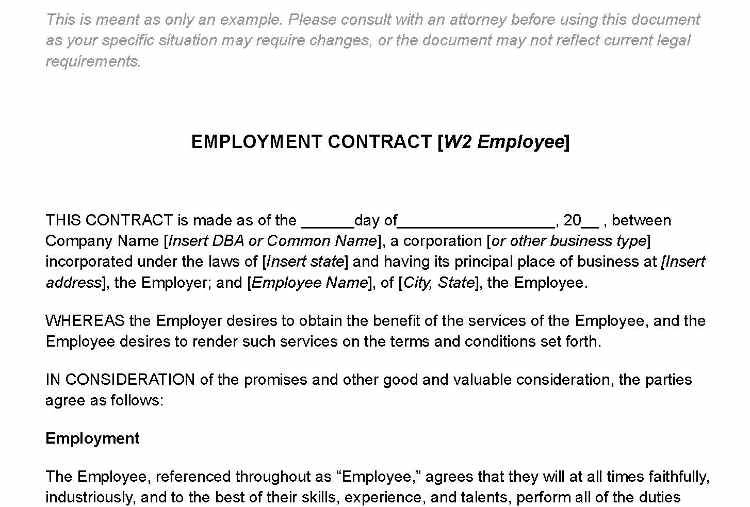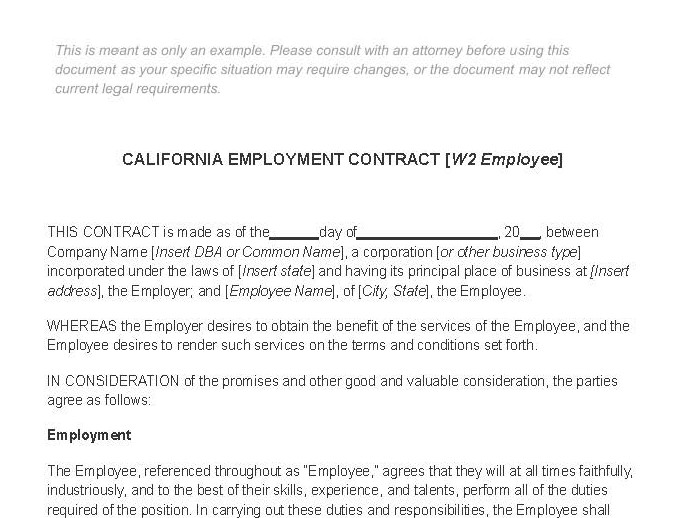![]()
This article is part of a larger series on Hiring.
Get Your Free Hiring Ebook
Send to me![]()
FILE TO DOWNLOAD OR INTEGRATE
W2 Employee Contract Template
Download as Word Doc Download as Google Doc Download as PDF
You can simplify the onboarding process by having your employees fill in their information with Gusto. Gusto is an all-in-one payroll, benefits & HR tool that’ll make bringing on your new employees a breeze.
Select Download Type FILE TO DOWNLOAD OR INTEGRATE W2 Employment Contract California Template Download as Word Doc Download as Google Doc Download as PDF
You can simplify the onboarding process by having your employees fill in their information with Gusto. Gusto is an all-in-one payroll, benefits & HR tool that’ll make bringing on your new employees a breeze.
Select Download TypeAn employment contract is a written employment agreement documenting the shared rights and responsibilities between your company and a W-2 employee. A strong employment contract should include terms of agreement, the employee’s responsibilities, compensation and benefits, and a nondisclosure agreement (NDA), among other items, and will help ensure all parties are aligned and all laws are followed. We’ve provided a general employment contract template for you to download and use, as well as a California-specific template since the state has numerous laws and regulations that make creating contracts a bit more complex.
Note: If you need an agreement to use with an independent contractor (1099 worker), don’t use an employment contract since independent contractors aren’t employees and shouldn’t be referred to as such. Check out our article on hiring independent contractors and download our free independent contractor agreement for more information.
An employment agreement template works as a fill-in-the-blank document. You add your company name and logo plus the worker’s name along with dates and payment info. The benefit of starting with an employment contract template is that much of the wording is boilerplate. You only need to change details specific to your business and any agreements made with the worker. Beyond describing your company and details of the job that the employee is being hired for, the employment contract should address compensation, benefits, and employment terms. In addition, it’s helpful to include a clause to ensure confidentiality and clarify how disputes will be resolved. Here are six critical sections to include in employment contracts:
1. Introduction & Terms of AgreementThe introduction should include information like company name, employee name, contract start date, and so forth. Our template provides fill-in-the-blank placeholders with subsections for you to provide these basics. For the terms of agreement, your contract should include language that directs the employee to follow all company procedures, rules, and regulations.
2. Worker ResponsibilitiesClearly defining job responsibilities in an employee contract template sets expectations about an employee’s role at your company. This is essential to prevent miscommunication. It’s often easiest to attach an existing job description if you have one; if not, summarize the position’s key responsibilities within that section of the template. Many employment contracts and job descriptions will state “additional duties as assigned” or something similar. This leaves you free to adjust the employee’s responsibilities later should the need arise. Be aware this only applies to minor changes. If the job changes significantly, you may need to provide the employee with a new contract.
3. Compensation & BenefitsDid You Know? When creating your employment contract template be aware that three states do not allow “use-it-or-lose-it” paid time off policies—California, Colorado, and Montana. Be sure to include language that states how many days can be rolled over per year in your contract. Learn more about creating a PTO policy and legal issues in your state.
4. Probationary Period and At-will EmploymentIf your business has a probationary period, include this language in your employment contract. Typically, a probationary period is a set amount of time (up to 90 days) where the employee is not eligible for benefits, such as paid time off, 401k contributions, or healthcare coverage.
An at-will employment clause should be added to any employment contract so that there is no question as to whether a worker can be terminated. This protects both parties consistent with US labor law. Because at-will employment is the default in the US and applies even without an employment agreement, if you have an employment agreement but do not include at-will language, it could restrict your ability to terminate the employee.
Montana is the exception to the at-will employment rule, as it limits at-will termination to just an employee’s probationary period—which is generally a year. Most states do allow further exceptions to at-will employment (often because of violations of public policy). You can check your state’s at-will employment exceptions using our interactive map.
If you and the employee agree in advance to terms like 30 days’ notice or severance payments, be sure to include that language in the contract itself. Our template includes standard language you’re welcome to modify as part of the employment terms.
5. Confidentiality ClauseTo protect the confidentiality of your business, you can include clauses in your contract similar to the one provided in our employee agreement template, which prohibit employees from disclosing confidential information outside of the company.
You can also take it a step further to state that employees are not allowed to engage in outside businesses that directly compete with your company. However, be sure not to use language that prohibits an employee from seeking gainful employment upon termination from your company, as new rules have been proposed.
In the News:
The Federal Trade Commission (FTC) has proposed a new rule that could ban non-compete clauses between employers and employees in all 50 states. This is based on their finding that non-competes constitute an unfair method of competition and therefore violate Section 5 of the Federal Trade Commission Act.
Additionally, a group of US Senators has reintroduced a bill, the “Workforce Mobility Act of 2023,” that would largely ban the use of employer non-compete agreements nationwide per federal law.
This section of your contract of employment notifies the employee that once signed the current contract supersedes any previously signed contracts. Additionally, this is the section to state that this contract may be amended in the future only by written and signed documentation.
7. Authorization to WorkIt is required by law that within three (3) business days of hire, employers must collect documentation that proves the employee is authorized to work in the United States. Your employment contract should notify the employee that such documentation will be collected, per an I9 form. The employee should provide either a passport or their original driver’s license and social security card as proof of their right to work.
For more information on how to fill out an I9 form, visit our guide. 8. Severability of ContractThis notifies employees that if any part of the contract becomes unenforceable or invalid, that only that part will be stricken from the contract. The remaining parts of the contract will remain valid and enforceable.
9. SignaturesBoth the employer and the employee’s signatures are required for the employment agreement to be valid. A document that both parties do not sign is hard to defend in a court of law, as the person who didn’t sign it can claim they didn’t know about it.
You should keep a copy of the signed document, as should the employee. It’s best to have both parties sign and date the employment contract before work begins to avoid potential issues or misunderstandings.
Be sure your contracts do not violate any labor laws, especially non-discrimination laws, as these could result in legal issues.
Both employers and employees can benefit from an employment contract. However, it’s in your best interest to write the employment contract in a way that preserves your rights as an employer, such as by specifying the amount of advanced notice you need to receive from the worker if they resign (for them to be eligible for bonuses or severance).
Using an employment contract can go a long way toward eliminating confusion from the start; however, it can also create more work for you and is sometimes costly. The primary benefit of documenting your employment agreement in a written contract is that it clarifies expectations all around and provides you with an assurance that work will be done as expected.
| PROS | CONS |
|---|---|
| Expectations are clear: It’s less likely you’ll have issues with the work or the worker. | Could damage employee trust: It may make your employment relationship feel too formal. For entry-level roles, an employee handbook is often enough. |
| Legally binding: If signed and dated by both parties, it will likely stand up in court. | Needs to be maintained: If you don’t update it regularly, it may work against you. Work terms may change from year to year, or your contract may have expired. |
| Remedy is available: If a breach of contract occurs, you may be able to request damages. | Costly: Having your contract reviewed and updated regularly costs money. |
| Protects your business: A signed contract protects your business trade secrets, client list, and prevents employees from disclosing sensitive information. | Might violate the law: If contract terms don’t meet legal requirements, the document may be unenforceable, or worse, subject you to a labor law violation. |
Different from an employment contract, a job offer letter is a more common way that businesses clarify the employment relationship with direct-hire employees. In an offer letter, you specify the hire date, pay rate, and job title and spell out any other pertinent agreed-upon information, such as a hiring bonus or extra paid time off.
The differences between a job offer letter and a more formal employment contract are: